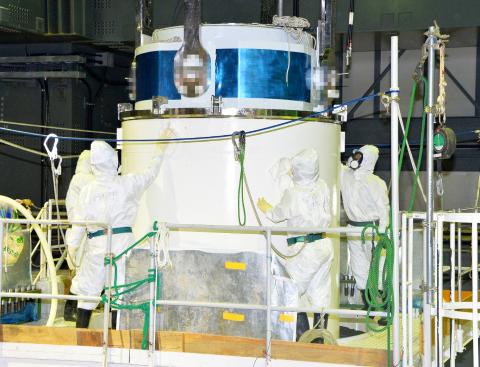The cleanup of Japan’s devastated Fukushima Dai-ichi nuclear power plant passed an important milestone on Saturday when the plant’s operator announced it had safely removed the radioactive fuel from the most vulnerable of the four heavily damaged reactor buildings.
Tokyo Electric Power Co (TEPCO) removed the remaining fuel rods from the ruined No. 4 reactor building, putting the rods inside a large white container for transportation to another, undamaged storage pool elsewhere on the plant’s grounds. The company had put a high priority on removing about 1,500 fuel rods from the unit because they sat in a largely unprotected storage pool on an upper floor of the building, which was gutted by a powerful hydrogen explosion during the March 2011 accident.
This led to fears of additional releases of radioactive material if the pool was damaged further, such as by an earthquake. By succeeding in the technically difficult task of extracting the rods, TEPCO eliminated one of the plant’s most worrying vulnerabilities. This is also the first time that fuel has been removed from one of the four wrecked reactor buildings.

Photo: AFP
It took almost four years to reach this goal, as the cleanup has been plagued by mishaps and a so far unstoppable flow of groundwater that has flooded the basements of the crippled reactor buildings.
The aging Fukushima Dai-ichi plant suffered a triple meltdown when a huge earthquake and tsunami struck on March 11, 2011, knocking out cooling systems.
TEPCO still faces the far more challenging task of removing the ruined fuel cores from the three reactors that melted down in the accident. These reactors were so damaged — and their levels of radioactivity remain so high — that removing their fuel is expected to take decades. Some experts have said it might not be possible at all, and have called instead for encasing those reactors in concrete.
The fuel cores from the three reactors are believed to have melted like wax as the uncooled reactors overheated, forming lumps on the bottom of the reactor vessels. Scientists have said that the hot, molten uranium might have even melted through the containment vessels, possibly reaching the floor of the reactor buildings or even the earth beneath.

CROSS-STRAIT COLLABORATION: The new KMT chairwoman expressed interest in meeting the Chinese president from the start, but she’ll have to pay to get in Beijing allegedly agreed to let Chinese Nationalist Party (KMT) Chairwoman Cheng Li-wun (鄭麗文) meet with Chinese President Xi Jinping (習近平) around the Lunar New Year holiday next year on three conditions, including that the KMT block Taiwan’s arms purchases, a source said yesterday. Cheng has expressed interest in meeting Xi since she won the KMT’s chairmanship election in October. A source, speaking on condition of anonymity, said a consensus on a meeting was allegedly reached after two KMT vice chairmen visited China’s Taiwan Affairs Office Director Song Tao (宋濤) in China last month. Beijing allegedly gave the KMT three conditions it had to

STAYING ALERT: China this week deployed its largest maritime show of force to date in the region, prompting concern in Taipei and Tokyo, which Beijing has brushed off Deterring conflict over Taiwan is a priority, the White House said in its National Security Strategy published yesterday, which also called on Japan and South Korea to increase their defense spending to help protect the first island chain. Taiwan is strategically positioned between Northeast and Southeast Asia, and provides direct access to the second island chain, with one-third of global shipping passing through the South China Sea, the report said. Given the implications for the US economy, along with Taiwan’s dominance in semiconductors, “deterring a conflict over Taiwan, ideally by preserving military overmatch, is a priority,” it said. However, the strategy also reiterated

‘BALANCE OF POWER’: Hegseth said that the US did not want to ‘strangle’ China, but to ensure that none of Washington’s allies would be vulnerable to military aggression Washington has no intention of changing the “status quo” in the Taiwan Strait, US Secretary of Defense Pete Hegseth said on Saturday, adding that one of the US military’s main priorities is to deter China “through strength, not through confrontation.” Speaking at the annual Reagan National Defense Forum in Simi Valley, California, Hegseth outlined the US Department of Defense’s priorities under US President Donald Trump. “First, defending the US homeland and our hemisphere. Second, deterring China through strength, not confrontation. Third, increased burden sharing for us, allies and partners. And fourth, supercharging the US defense industrial base,” he said. US-China relations under

The Chien Feng IV (勁蜂, Mighty Hornet) loitering munition is on track to enter flight tests next month in connection with potential adoption by Taiwanese and US armed forces, a government source said yesterday. The kamikaze drone, which boasts a range of 1,000km, debuted at the Taipei Aerospace and Defense Technology Exhibition in September, the official said on condition of anonymity. The Chungshan Institute of Science and Technology and US-based Kratos Defense jointly developed the platform by leveraging the engine and airframe of the latter’s MQM-178 Firejet target drone, they said. The uncrewed aerial vehicle is designed to utilize an artificial intelligence computer